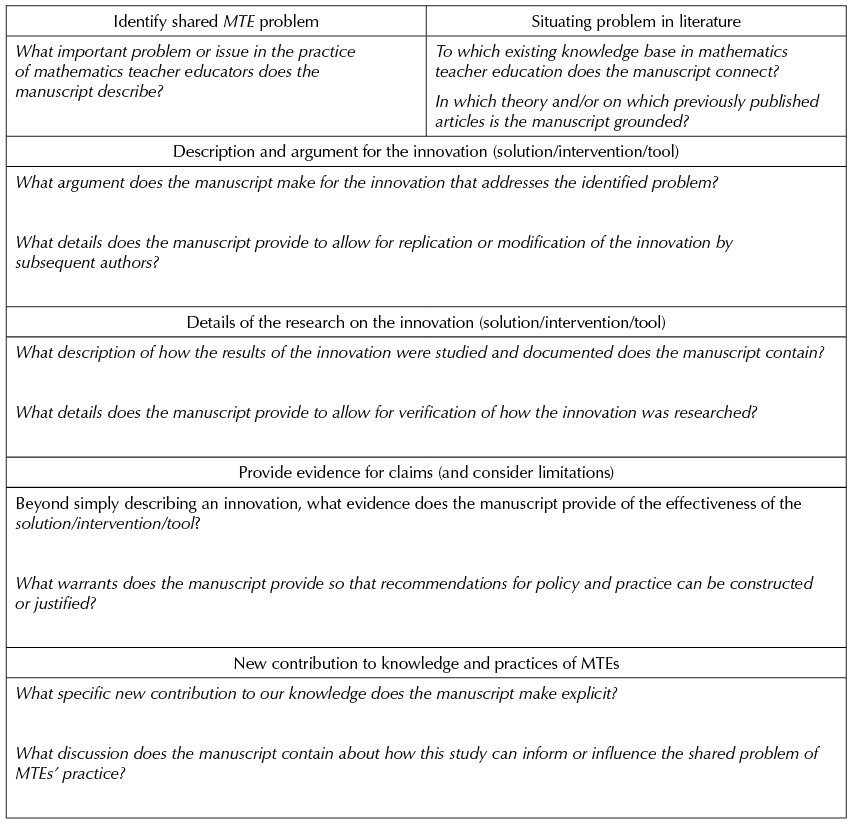When describing MTE, we often hear things like, “It is a practitioner journal,” “It is not like JRME,” and “It is more rigorous than MT, MTMS, or TCM journals.” All these things are true but do not quite capture what it is that makes MTE a journal dedicated to growing the knowledge base of mathematics teacher educators. What this says is that it is easier to state what MTE is not, and much more difficult to provide a clear-cut description of what the journal publishes. MTE is a journal attempting to do something that no other journal, not even those in other disciplines, has done. Although it may be convenient to try to understand the journal and the kinds of articles it publishes by comparing it with other journals we are familiar with, these comparisons ultimately fall short of providing the support needed to generate a manuscript that is a good “fit” for MTE. In this editorial, we offer a tool that could help prospective authors conceptualize and write manuscripts for this journal.
1. How to Craft a Manuscript That Is a Good “Fit” for MTE
One important place to begin the quest of getting published is to consider the journal’s history and learn as much as you can about its trajectory, where the journal has been and where it seems to be going. Although MTE is still a relatively young journal, it is beginning to find its identity as a journal that invests in supporting authors’ and reviewers’ capacity to participate in the publication process of the journal and works toward the ultimate goal of developing the field’s capacity to grow its knowledge base.
An important tradition for this journal is that each issue includes an editorial that reaches out to the readers, authors, and reviewers of the journal to make more explicit and to help demystify the publication process. Hence, one way to learn about how to write and how to review for this journal is to invest a bit of time reading through past editorials, all of which are offered as free previews. In fact, in the most recent editorial, Bieda (Sept. 2016 issue) presented an overview of the topics relevant to the practice of mathematics teacher education that have been featured in the journal’s relatively brief 6-year history.
It is also important to consider that MTE was conceived as a joint effort between AMTE and NCTM, and the implications of both organizations’ involvement reach far beyond their financial investments. Both organizations are also invested in the conceptual direction for the journal, and both organizations have a rich history of supporting journals that make a difference for both practitioners and scholars. What this means is that MTE is also unique in how it is positioned within and across both of these organizations.
From its conception, MTE’s founding editors and editorial board recognized the difficulties prospective authors might have in writing manuscripts that fit the aims of the journal. The very first issue (http://www.nctm.org/Publications/mathematics-teacher-educator/2012/Vol1/Issue1/?ref=1) was published with each article available as a free preview to provide broad access to the kinds of manuscripts that address the journal’s aims. One common feature among the articles is that they clearly situate their work in a problem of practice relevant for mathematics teacher educators. In addition, each of the articles describes a method, tool, or innovation that the authors implemented to address a problem of practice. There are, however, differences in the approaches the authors took to assess the effectiveness of the method, tool, or innovation implemented. Although none of the articles has an explicit “Methods” section, they each involve the collection and analysis of data such as pre/post assessments (e.g., Steele & Hillen, 2012), interviews (e.g., van Zoest & Stockero, 2012), written responses (e.g., Groth, 2012), as well as an assortment of data, such as written work, typical of research traditions like action research (e.g., Fernandes, 2012 and Morris, 2012).
Despite the differences in the research methods used, all articles feature carefully stated claims about what the evidence says regarding the effectiveness of the method, tool, or innovation implemented. Doing this well is possibly the most difficult aspect of writing an article that is a good fit for MTE; we routinely see articles rejected by reviewers because the claims could not be substantiated by the evidence provided or were not significant enough to warrant the use of the method, tool or innovation by other mathematics teacher educators. Margaret (Peg) Smith wrote her second editorial as the founding editor of MTE on precisely the issue of linking claims to evidence (http://www.nctm.org/Publications/mathematics-teacher-educator/2013/Vol1/Issue2/EDITORIAL_-Linking-Claims-and-Evidence/), and this particular issue continues to challenge prospective authors.
Over time, there have not only been editorials but also webinars and conference sessions (http://www.nctm.org/uploadedFiles/Publications/mathematics_teacher_educator/MTE%20for%20NCTM%202014.pdf) that have worked to clarify the review criteria for MTE and share insights, from MTE authors, about crafting manuscripts that are a good fit for the MTE journal. Conference session topics have provided prospective authors with access to formative feedback from senior scholars and have featured authors discussing how the process of “revising and resubmitting” helped them refine their manuscript to better meet the journal’s review criteria. We have learned from interacting with prospective authors in these sessions that the uniqueness of MTE demands different strategies for producing manuscripts than those you might typically use. In this issue, we offer a writing tool to support you in crafting a manuscript that addresses MTE’s unique review criteria.
2. A Tool for Planning, Writing, and Assessing Your Manuscript
Inspired by the recurring question of “does my manuscript fit your journal?” that we frequently address as MTE editors, we conceptualized and developed a writing tool or template that could help future MTE authors evaluate their manuscripts’ fit to this journal. We tested the template within our editorial office and also shared it with prospective authors who were willing to try it and help us refine the tool. We also shared this tool at the 2016 and 2017 MTE journal sessions at both the AMTE and the NCTM annual meetings, and we have had various discussions, both formal and informal, with prospective authors who have tested the MTE template (see Figure 1). This helped us to better understand how this tool could be used by prospective authors of the journal to assess the potential fit of their manuscripts to the aims of the MTE journal.
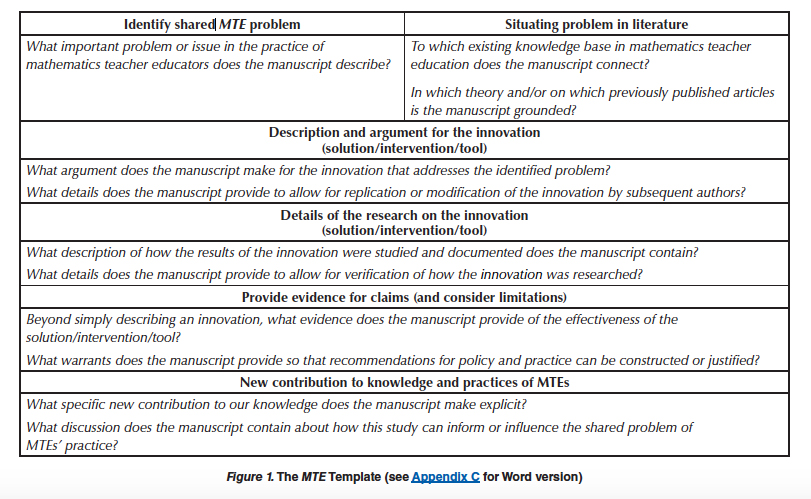
Notice that each cell of the template corresponds to one of the manuscript review criteria and includes questions that correspond to the journal’s review criteria to guide the development of an actual (or imagined) manuscript.
1. The manuscript contains a description of the problem or issue of mathematics teacher education that is addressed; the methods/interventions/tools that were used; the means by which these methods/interventions/tools and their results were studied and documented; and the application of the results to practice (both the authors’ practice and that of the larger community).
2. The manuscript provides a connection to the existing knowledge base in mathematics teacher education and is grounded in theory and/or on previously published articles.
3. The manuscript goes beyond simply describing an innovation to providing evidence of the effectiveness of the innovation being described.
4. The manuscript makes explicit the specific new contribution to our knowledge. Findings should be reported with enough warrants so that recommendations for policy and practice can be constructed or justified.
5. The manuscript provides sufficient detail to allow for verification, replication in other contexts, or modification by subsequent authors.
In comparing the cell headings with the prompts (in the form of questions), you will notice that Review Criteria 1 has been split across two cells. The reason for this is because Review Criteria 1 is lengthier and because we have found over our tenure as editors that submitted manuscripts typically have weaknesses in describing their innovation (method/innovation/tool), discussing how their innovation (method/innovation/tool) was assessed, or making convincing claims about the implications for practice rather than falling short across all three aspects of the criteria.
There are at least a few ways to use this template. One way is to take an existing manuscript and attempt to fill in the cells with answers to the questions to figure out the strengths and weaknesses of your manuscript in relation to the journal’s criteria. Another way to use the MTE template would be to have one or more kind colleagues read your manuscript and fill in the cells based on their read of the manuscript. One could imagine the template could be useful for a writing group where one or more authors is preparing submissions for MTE. Yet another possibility would be to imagine what those answers might be prior to drafting the manuscript. Those answers could be translated into text for the manuscript’s abstract, an excellent place to start a draft. For additional guidance in drafting abstracts, we highly recommend Wendy Belcher’s (2009) practical guide, Writing Your Journal Article in 12 Weeks.
A key feature of the template is that the cells correspond to how the argument should unfold in the manuscript. The template links the review criteria with temporal placement within the manuscript that the original organization of the five review criteria did not. In essence, the manuscript story should unfold in three stages: (1) setting up the central problem of practice that the method/solution/tool attempts to address, including a review of relevant literature speaking to the importance of this problem and any theoretical or conceptual frameworks that have informed the development of the method/solution/tool; (2) describing the method/solution/tool and its use in a teacher education context, describing methods used to determine the effectiveness of the method/solution/tool and the extent to which the implementation of the method/solution/tool was successful as revealed through an analysis of evidence collected before, during, and/or after implementation; (3) making recommendations for MTEs’ practice based on the findings and implications for use of the method/solution/tool by other MTEs.
3. Using the MTE Template
To illustrate how to use the MTE writing tool, we use two of the published articles from this current issue. Appendixes A–B show how the template could be filled out while also showcasing how manuscripts that fit the journal would look in relation to the questions/prompts in each of the cells of the template.
We invited two graduate assistants who assist with the journal, José Martinez Hinestroza and Christopher Dubbs, to use the template with two of the accepted manuscripts for this issue. This was, in part, an exercise to test the template (and the validity of our review process); we wanted to make sure that the template could easily be completed from a read of an accepted manuscript. What the use of the template illuminates is that articles with different foci and different kinds of evidence can address the questions raised in the template. We encourage you to read the articles in this issue and critically examine the entries in the template for each article to better understand the essential features of MTE manuscripts. We think, especially examining these two articles, that you will come to see that the aims of MTE accommodate a wide range of foci and research methods.
We hope this tool inspires you to craft a manuscript for MTE! If you have not submitted a manuscript for review to MTE before, we strongly encourage you to pick a few articles published in MTE that relate to the topic of your work and “read” them by filling in the template. Struggling to answer the questions in one or more boxes as you draft your manuscript does not mean your manuscript is not a good fit for MTE; rather, it may mean that you need to rewrite or reframe the arguments you make in your manuscript to more clearly address the journal’s review criteria. We invite you to contact us, sharing an abstract and maybe your draft template, to initiate feedback from the editorial team to help you to craft your manuscript for MTE.
We also invite prospective authors to use the MTE template as they read this issue. Perhaps try it on the other two articles to get a feel for how this tool could be used to review and prepare manuscripts. We look forward to authors sharing with us how they used the MTE template to write their manuscripts and to receiving many more manuscripts that clearly fit the journal’s goals and criteria and, thus, make it to publication. We hope this editorial helps settle the question of whether manuscripts fit the journal and that authors can focus their writing on strengthening their claims and the ways in which they frame their work so as to explicitly address and contribute to the practice of mathematics teacher educators.
References
Amador, J., Estapa, A., de Araujo, Z., Kosko, K., & Weston, T. (2017). Eliciting and analyzing preservice teachers’ mathematical noticing. Mathematics Teacher Educator, 5(2), 158–177.
Belcher, W. L. (2009). Writing your journal article in 12 weeks: A guide to academic publishing success. Thousand Oaks, CA: Sage.
Bieda, K. (2016). Taking stock: MTE’s contribution to building a knowledge base for the practice of mathematics teacher education. Mathematics Teacher Educator, 5(1), 3–7.
Fernandes, A. (2012). Mathematics preservice teachers learning about English language learners through task-based interviews and noticing. Mathematics Teacher Educator, 1(1), 10–22.
Gallivan, H. R. (2017). Supporting prospective teachers’ learning to revise a high-level mathematics task to be culturally relevant. Mathematics Teacher Educator, 5(2), 94–121.
Groth, R. E. (2012). The role of writing prompts in a statistical knowledge for teaching course. Mathematics Teacher Educator, 1(1), 23–40.
Morris, A. K. (2012). Using “lack of fidelity” to improve teaching. Mathematics Teacher Educator, 1(1), 71–101.
Smith, M. (2013). Linking claims and evidence. Mathematics Teacher Educator, 1(2), 105–107.
Steele, M. D., & Hillen, A. F. (2012). The content-focused methods course: A model for integrating pedagogy and mathematics content. Mathematics Teacher Educator, 1(1), 53–70.
Van Zoest, L. R., & Stockero, S. L. (2012). Capitalizing on productive norms to support teacher learning. Mathematics Teacher Educator, 1(1), 41–52.
Appendix A: Supporting Prospective Teachers’ Learning to Revise a High-Level Mathematics Task to Be Culturally Relevant, by Heather R. Gallivan
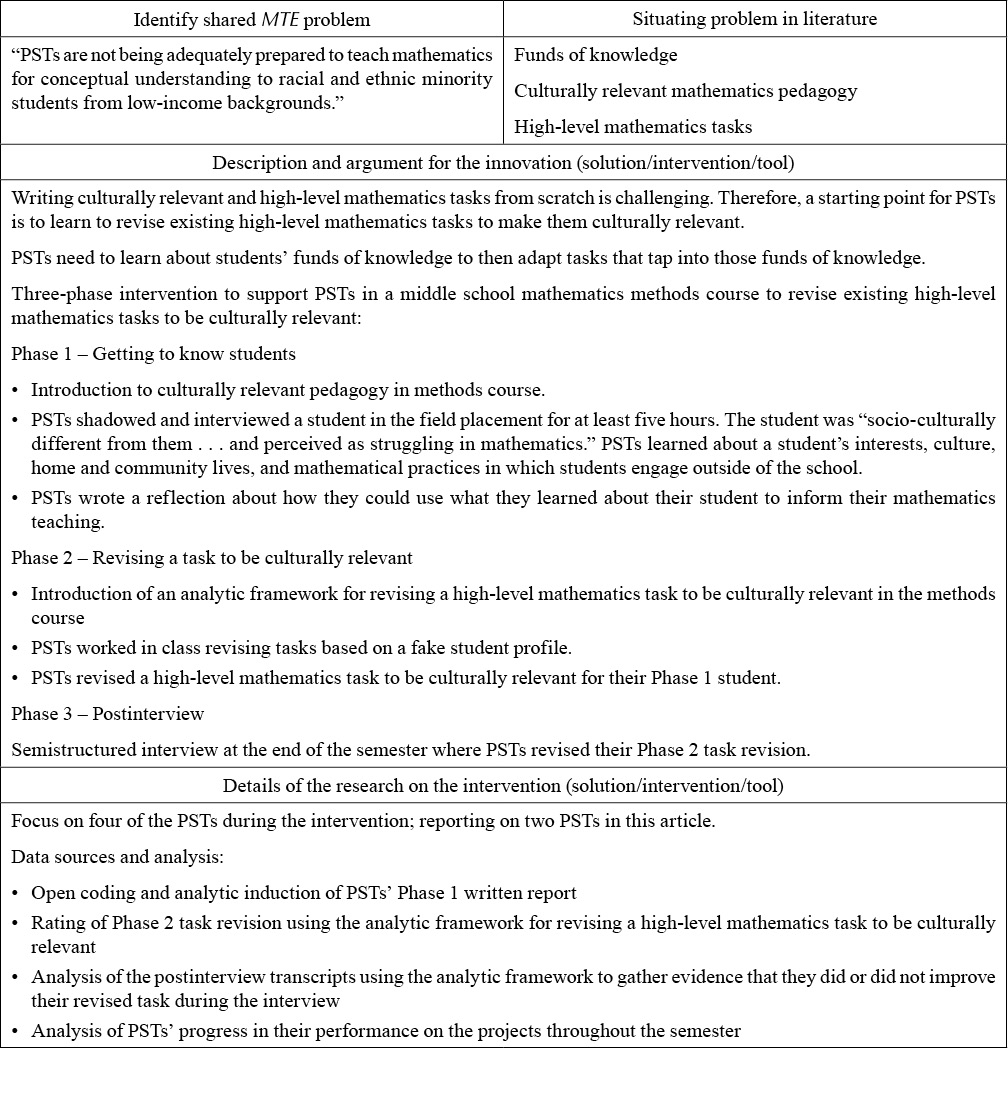

Appendix B: Eliciting and Analyzing Preservice Teachers’ Mathematical Noticing, by Julie Amador, Anne Estapa, Zandra de Araujo, Karl Kosko, and Tracy L. Weston
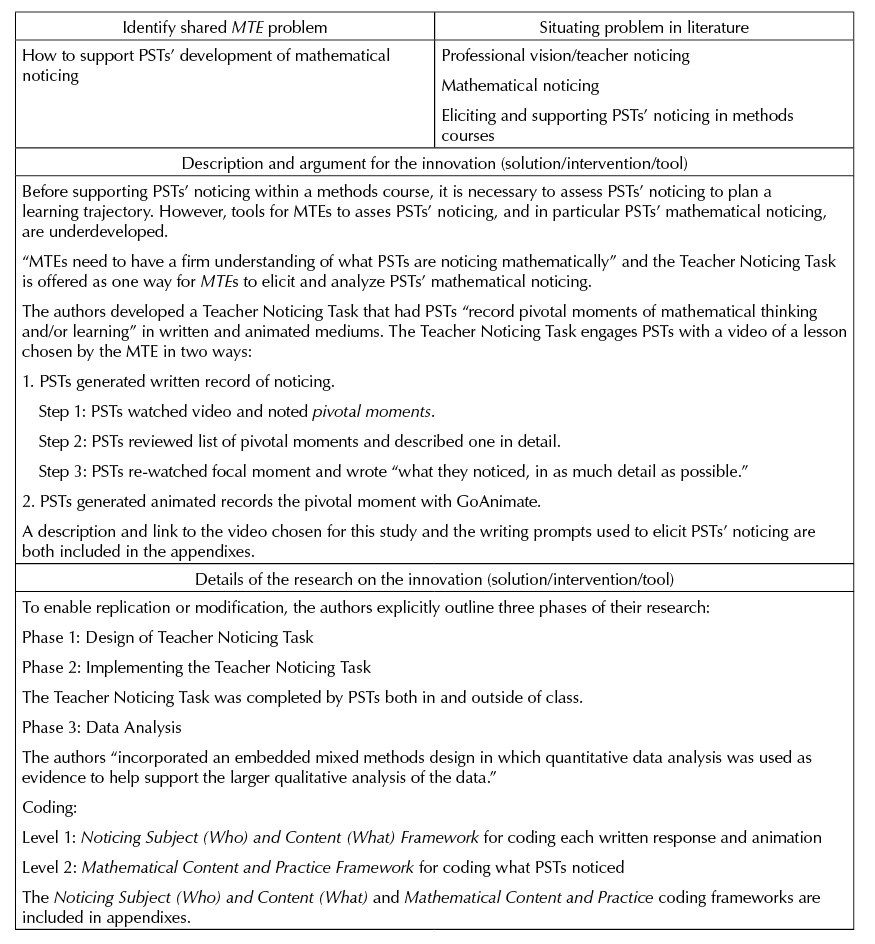
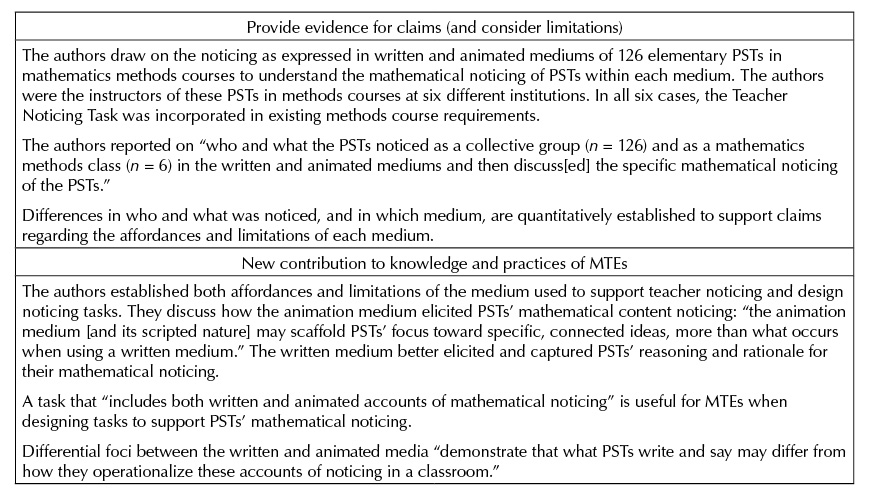
Appendix C: Template as a Word Doc
Identify shared MTE problem Situating problem in literature
